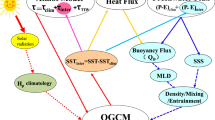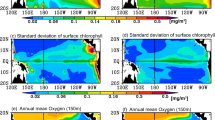Abstract
Recent modeling studies have demonstrated that ocean biology plays a significant role in modulating the climate over the tropical Pacific through its effect on the vertical distribution of sunlight in the upper ocean, which can be simply represented by penetration depth (Hp). Previously, remotely sensed ocean color data have been used to derive an empirical model to depict interannual Hp variability (H′p) in the region. The derived H′p model is then incorporated into a hybrid coupled model (HCM) of the tropical Pacific to parameterize ocean biology-induced heating (OBH) effects. In this paper, outputs from the HCM simulations are diagnosed to reveal the structure and variability of OBH terms that are directly influenced by Hp and the depth (Hm) of the mixed layer (ML), including the penetrative solar radiation flux out of the ML (Qpen), the fraction absorbed within the ML (Qabs), and the related time rate of change of the ML temperature (Rsr). Coherent relationships are found among interannual variations in Hp, Hm, Qpen, Qabs and Rsr, with geographical dependence. It is found that Hp tends to have largest interannual variations over the western-central equatorial Pacific where its effects on Qpen are out of phase with those of Hm during ENSO cycles. It is further demonstrated that Qpen is a field whose interannual variability is significantly enhanced by H′p in the western-central equatorial region; the resultant differential heating in the vertical between the ML and subsurface layers acts to modulate the thermal stratification, the stability, vertical mixing and entrainment in the upper ocean. These induced ocean processes further affect sea surface temperatures in the equatorial Pacific.















Similar content being viewed by others
References
Anderson WG, Gnanadesikan A, Hallberg R, Dunne J, Samuels BL (2007) Impact of ocean color on the maintenance of the Pacific Cold Tongue. Geophys Res Lett 34:L11609. doi:10.1029/2007GL030100
Anderson WG, Gnanadesikan A, Wittenberg A (2009) Regional impacts of ocean color on tropical Pacific variability. Ocean Sci 5:313–327
Ballabrera-Poy J, Murtugudde RG, Christian JR, Busalacchi AJ (2003) Signal-to-noise ratios of observed monthly tropical ocean color. Geophys Res Lett 30(12):1645. doi:10.1029/2003GL016995
Ballabrera-Poy J, Murtugudde RG, Zhang R-H, Busalacchi AJ (2007) Coupled ocean-atmosphere response to seasonal modulation of ocean color: impact on interannual climate simulations in the tropical Pacific. J Clim 20:353–374
Bjerknes J (1969) Atmospheric teleconnections from the equatorial Pacific. Mon Weather Rev 97:163–172
Chavez F, Strutton P, McPhaden M (1998) Biological-physical coupling in the central equatorial Pacific during the onset of the 1997–1998 El Niño. Geophys Res Lett 25(19):3543–3546
Chavez FP, Strutton PG, Friedrich GE, Feely RA, Feldman GC, Foley DG, McPhaden MJ (1999) Biological and chemical response of the equatorial Pacific ocean to the 1997–1998 El Niño. Science 286:2126–2131
Chen D, Rothstein LM, Busalacchi AJ (1994) A hybrid vertical mixing scheme and its application to tropical ocean models. J Phys Oceanogr 24:2156–2179
Dunne JP et al (2012) GFDL’s ESM2 global coupled climate-carbon earth system models. Part I: physical formulation and baseline simulation characteristics. J Clim 25:6646–6665
Gent P, Cane MA (1989) A reduced gravity, primitive equation model of the upper equatorial ocean. J Comput Phys 81:444–480
Hackert E, Busalacchi A, Murtugudde R (2001) A wind comparison study using an ocean general circulation model for the 1997–1998 El Niño. J Geophys Res 106:2345–2362
Jochum M, Yeager S, Lindsay K, Moore K, Murtugudde R (2010) Quantification of the feedback between phytoplankton and ENSO in the Community Climate System Model. J Clim 23:2916–2925
Lengaigne M, Menkes C, Aumont O, Gorgues T, Bopp L, André J-M, Madec G (2007) Influence of the oceanic biology on the tropical Pacific climate in a coupled general circulation model. Clim Dyn 28:503–516
Levitus S, Antonov JI, Boyer TP (2005) Warming of the World Ocean, 1955–2003. Geophys Res Lett 32:L02604. doi:10.1029/2004GL021592
Lewis MR, Carr ME, Feldman GC, Esias W, McClain C (1990) Influence of penetrating solar radiation on the heat budget of the Equatorial Pacific. Nature 347:543–546
Manizza M, Le Quéré C, Watson AJ, Buitenhuis ET (2005) Bio-optical feedbacks among phytoplankton, upper ocean physics and sea-ice in a global model. Geophys Res Lett 32:L05603. doi:10.1029/2004GL020778
Marzeion B, Timmermann A, Murtugudde R, Jin F–F (2005) Biophysical feedbacks in the tropical Pacific. J Clim 18:58–70
McClain CR, Cleave ML, Feldman GC, Gregg WW, Hooker SB, Kuring N (1998) Science quality SeaWiFS data for global biosphere research. Sea Technol 39:10–16
Miller AJ, Alexander MA (2003) Potential feedbacks between Pacific ocean ecosystems and internannual variations. Bull Amer Meteor Soc 84:617–633
Murtugudde R, Busalacchi AJ (1998) Salinity effects in a tropical ocean model. J Geophys Res 103:3283–3300
Murtugudde R, Seager R, Busalacchi AJ (1996) Simulation of tropical oceans with an ocean GCM coupled to an atmospheric mixed layer model. J Clim 9:1795–1815
Murtugudde R, Beauchamp J, McClain CR, Lewis M, Busalacchi AJ (2002) Effects of penetrative radiation on the upper tropical ocean circulation. J Clim 15:470–486
Nakamoto S, Kumar S, Oberhuber J, Ishizaka J, Muneyama K, Frouin R (2001) Response of the equatorial Pacific to chlorophyll pigment in a mixed layer isopycnal ocean general circulation model. Geophys Res Lett 28(10):2021–2024
Ohlmann JC, Siegel DA, Washburn L (1998) Radiant heating of the western equatorial Pacific during TOGA-COARE. J Geophys Res 103:5379–5395. doi:10.1029/97JC03422
Paulson CA, Simpson JJ (1977) Irradiance measurements in the upper ocean. J Phys Oceanogr 7:952–956
Reynolds RW, Rayner NA, Smith TM, Stokes DC, Wang W (2002) An improved in situ and satellite SST analysis for climate. J Clim 15:1609–1625
Rochford PA, Kara AB, Wallcraft AJ, Arnone RA (2001) Importance of solar subsurface heating in ocean general circulation models. J Geophys Res 106:30923–30938. doi:10.1029/2000JC000355
Rothstein LM, Zhang R-H, Busalacchi AJ, Chen D (1998) A numerical simulation of the mean water pathways in the subtropical and tropical Pacific Ocean. J Phys Oceanogr 28:322–343
Schneider EK, Zhu Z (1998) Sensitivity of the simulated annual cycle of sea surface temperature in the equatorial Pacific to sunlight penetration. J Clim 11:1932–1950
Seager R, Blumenthal M, Kushinir Y (1995) An advective atmospheric mixed layer model for ocean modeling purposes: global simulation of surface heat fluxes. J Clim 8:1951–1964
Siegel DA et al (1995) Solar radiation, phytoplankton pigments and the radiant heating of the equatorial Pacific warm pool. J Geophys Res 100:4885–4891
Strutton PG, Chavez FP (2004) Biological heating in the equatorial Pacific: observed variability and potential for real-time calculation. J Clim 17:1097–1109
Sweeney C, Gnanadesikan A, Griffies SM, Harrison MJ, Rosati AJ, Samuels BL (2005) Impacts of shortwave penetration depth on large-scale ocean circulation and heat transport. J Phys Oceanogr 35:1103–1119
Timmermann A, Jin F–F (2002) Phytoplankton influences on tropical climate. Geophys Res Lett 29:2104. doi:10.1029/2002GL015434
Wang XJ, Christian J, Murtugudde R, Busalacchi A (2005) Ecosystem dynamics and export production in the central and eastern equatorial Pacific: a modeling study of impact of ENSO. Geophys Res Lett 32:L02608. doi:10.1029/2004GL021538
Wang XJ, Christian JR, Murtugudde R, Busalacchi AJ (2006) Spatial and temporal variability in new production in the equatorial Pacific during 1980–2003: physical and biogeochemical controls. Deep-Sea Res 53:677–697
Wetzel P, Maier-Reimer E, Botzet M, Jungclaus J, Keenlyside N, Latif M (2006) Effects of ocean biology on the penetrative radiation in a coupled climate model. J Clim 19:3973–3987
Wittenberg AT (2009) Are historical records sufficient to constrain ENSO simulations? Geophys Res Lett 36:L12702. doi:10.1029/2009GL038710
Zhang R-H, Busalacchi AJ (2009) Freshwater flux (FWF)-induced oceanic feedback in a hybrid coupled model of the tropical Pacific. J Clim 22(4):853–879
Zhang R-H, Levitus S (1997) Interannual variability of the coupled Tropical Pacific ocean-atmosphere system associated with the El Nino/Southern Oscillation. J Clim 10:1312–1330
Zhang R-H, Rothstein LM (1998) On the phase propagation and relationship of interannual variability in the tropical Pacific climate system. Clim Dyn 14:713–723
Zhang R-H, Zebiak SE (2002) Effect of penetrating momentum flux over the surface mixed layer in a z-coordinate OGCM of the Tropical Pacific. J Phys Oceanogr 32:3616–3637
Zhang R-H, Busalacchi AJ, DeWitt DG (2008) The roles of atmospheric stochastic forcing (SF) and oceanic entrainment temperature (Te) in decadal modulation of ENSO. J Clim 21(4):674–704
Zhang R-H, Busalacchi AJ, Murtugudde RG (2006) Improving SST anomaly simulations in a layer ocean model with an embedded entrainment temperature submodel. J Clim 19:4638–4663
Zhang R-H, Busalacchi AJ, Wang XJ, Ballabrera-Poy J, Murtugudde R, Hackert EC, Chen D (2009) Role of ocean biology-induced climate feedback in the modulation of El Niño-Southern Oscillation (ENSO). Geophys Res Lett 36:L03608. doi:10.1029/2008GL036568
Zhang R-H, Chen D, Wang G (2011) Using satellite ocean color data to derive an empirical model for the penetration depth of solar radiation (Hp) in the tropical Pacific Ocean. J Atmos Ocean Technol 28:944–965. doi:10.1175/2011JTECHO797.1
Zhang R-H, Zheng F, Zhu J, Pei Y, Zheng Q, Wang Z (2012) Modulation of El Niño-Southern Oscillation by freshwater flux and salinity variability in the Tropical Pacific. Adv Atmos Sci 29:647–660. doi:10.1007/s00376-012-1235-4
Acknowledgments
We would like to thank A. J. Busalacchi for his comments. We appreciate contributions from Ballabrera-Poy, J. and E. Hackert for the ocean color data and ocean modeling. The author wishes to thank the two anonymous reviewers for their numerous comments that helped to improve the original manuscript. This study is supported by the National Basic Research Program of China Project 2012CB956000 and IOCAS (WPOS) in China, and in part by NSF Grant (AGS-1061998) in USA.
Author information
Authors and Affiliations
Corresponding author
Rights and permissions
About this article
Cite this article
Zhang, RH. Structure and effect of ocean biology-induced heating (OBH) in the tropical Pacific, diagnosed from a hybrid coupled model simulation. Clim Dyn 44, 695–715 (2015). https://doi.org/10.1007/s00382-014-2231-4
Received:
Accepted:
Published:
Issue Date:
DOI: https://doi.org/10.1007/s00382-014-2231-4




